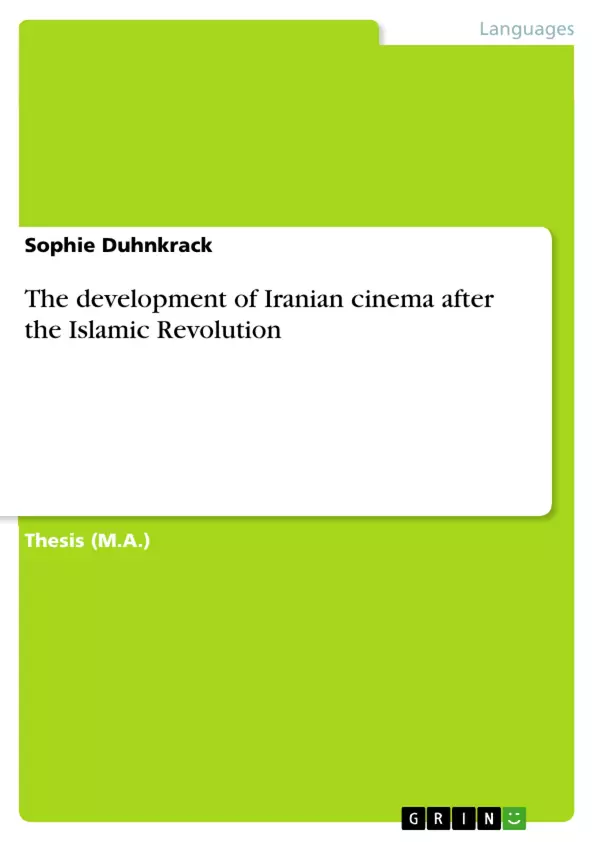An analysis of the recent development of Iranian Cinema should primarily mention its origins and history, especially since Iranian cinema always has been so closely linked to the political circumstances dominating the social reality. Its outset is generally accepted to have begun around 1900, when Mirza Ebrahim Khan Akkas Bashi, the official photographer of Muzaffar al-Din Shah, shot the first Iranian documentary.... As Richard Tapper states in his work, The New Iranian Cinema, “both government and religious authorities sought to control the images to be shown publicly.” ‘Formal censorship’ began in the 1920s, when the imported films exhibiting women, sex and amusement dominated the Iranian market. In contrast to this permissive attitude, depicting the political or social reality critically in local productions was taboo. Until the Second World War “nothing worthy of being called ‘national cinema’” was produced. In these decades, Iranian films were mainly remakes of foreign works, mainly Indian or Egyptian, and normally they lacked artistic quality. This genre of films is known as “Film Farsi.” Along with the development of film comes the history of censorship, which tries to curb the freedom of expression in increasingly institutionalized manners. Indeed, in 1950 a committee for the supervision of locally produced or imported films was established. This might have contributed to the fact that in the 1950s and 1960s, next to the import of American and Indian films, only “commercial films” were famous in Iran, whose sole aim was to entertain and to fill the cash tills. In this period too, the censorship worried more about the expression of political opinions than about the demonstration of sex. However, on the edge of mainstream productions slowly evolved few other interesting and formative films. “1969 is generally agreed to mark the birth of Iranian art cinema, called the New Wave.” In the following period various films were successfully presented to international film festivals. However, from its beginning on, the evolution of Iranian cinema was constantly accompanied by a consistent religious opposition. Through the lens of many Iranian clerics, films were immoral. They denounced cinema as a tool to access corrupt western influence into Iran. This suspicion and aversion against cinema, which was deep-rooted in many Iranian clergymen found later on as well expression in the Islamic Republic.
Table of Contents
- The Development of Iranian Cinema after the Islamic Revolution
- A Brief History of Iranian Cinema
- The Islamic Revolution and its Influence on Iranian Cinema
- The Institutional Framework
- The Economic Trend
- Censorship and its Impact
Objectives and Key Themes
This work aims to provide an analysis of the evolution of Iranian cinema following the Islamic Revolution of 1979. It examines the institutional, economic, and political factors that shaped the industry and analyzes the impact of censorship on the quality and artistic expression of Iranian films. Key themes explored in the text include:- The influence of the Islamic Revolution on Iranian cinema
- The role of censorship and political control in shaping the industry
- The development of a national cinema that reflects Islamic values
- The economic challenges faced by Iranian cinema
- The impact of censorship on the quality of Iranian films
Chapter Summaries
This section focuses on the development of Iranian cinema after the Islamic Revolution of 1979. It explores the impact of the revolution on the film industry, examining the institutional framework, the economic trend, and the influence of censorship. The text begins with a brief history of Iranian cinema, highlighting its origins and its relationship to political and social circumstances. It then delves into the Islamic Revolution and its profound effect on the film industry, discussing the establishment of new institutions, the implementation of a cultural policy, and the struggle to balance Islamic values with artistic expression. The text explores the early years following the revolution, highlighting the difficulties faced by the film industry in finding its footing. It then examines the role of the Supreme Council of the Cultural Revolution and the Ministry of Culture and Islamic Guidance in shaping the development of Iranian cinema. This work emphasizes the influence of the Islamic regime on Iranian cinema, analyzing the promotion of Islamic values, the suppression of Western influences, and the implementation of censorship policies.Keywords
This work explores the development of Iranian cinema in the context of the Islamic Revolution of 1979. Key terms and concepts include:- Iranian cinema
- Islamic Revolution
- Censorship
- Cultural policy
- National cinema
- Islamic values
- Political control
- Economic challenges
- Artistic expression
- Quote paper
- Sophie Duhnkrack (Author), 2009, The development of Iranian cinema after the Islamic Revolution, Munich, GRIN Verlag, https://www.grin.com/document/127506



